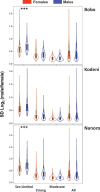Intraspecific Transcriptome Variation and Sex-Biased Expression in Anopheles arabiensis
- PMID: 34432020
- PMCID: PMC8449828
- DOI: 10.1093/gbe/evab199
Intraspecific Transcriptome Variation and Sex-Biased Expression in Anopheles arabiensis
Erratum in
-
Corrigendum to: Intraspecific Transcriptome Variation and Sex-Biased Expression in Anopheles Arabiensis.Genome Biol Evol. 2022 Feb 4;14(2):evab285. doi: 10.1093/gbe/evab285. Genome Biol Evol. 2022. PMID: 35182427 Free PMC article. No abstract available.
Abstract
The magnitude and functional patterns of intraspecific transcriptional variation in the anophelines, including those of sex-biased genes underlying sex-specific traits relevant for malaria transmission, remain understudied. As a result, how changes in expression levels drive adaptation in these species is poorly understood. We sequenced the female, male, and larval transcriptomes of three populations of Anopheles arabiensis from Burkina Faso. One-third of the genes were differentially expressed between populations, often involving insecticide resistance-related genes in a sample type-specific manner, and with the females showing the largest number of differentially expressed genes. At the genomic level, the X chromosome appears depleted of differentially expressed genes compared with the autosomes, chromosomes harboring inversions do not exhibit evidence for enrichment of such genes, and genes that are top contributors to functional enrichment patterns of population differentiation tend to be clustered in the genome. Further, the magnitude of variation for the sex expression ratio across populations did not substantially differ between male- and female-biased genes, except for some populations in which male-limited expressed genes showed more variation than their female counterparts. In fact, female-biased genes exhibited a larger level of interpopulation variation than male-biased genes, both when assayed in males and females. Beyond uncovering the extensive adaptive potential of transcriptional variation in An. Arabiensis, our findings suggest that the evolutionary rate of changes in expression levels on the X chromosome exceeds that on the autosomes, while pointing to female-biased genes as the most variable component of the An. Arabiensis transcriptome.
Keywords: Anopheles arabiensis; faster-X effect; functional diversification; sex-biased gene expression; transcriptome variation.
© The Author(s) 2021. Published by Oxford University Press on behalf of the Society for Molecular Biology and Evolution.
Figures






Similar articles
-
Behavioural plasticity of Anopheles coluzzii and Anopheles arabiensis undermines LLIN community protective effect in a Sudanese-savannah village in Burkina Faso.Parasit Vectors. 2020 Jun 1;13(1):277. doi: 10.1186/s13071-020-04142-x. Parasit Vectors. 2020. PMID: 32487147 Free PMC article.
-
Genome-wide gene expression profiling reveals that cuticle alterations and P450 detoxification are associated with deltamethrin and DDT resistance in Anopheles arabiensis populations from Ethiopia.Pest Manag Sci. 2019 Jul;75(7):1808-1818. doi: 10.1002/ps.5374. Epub 2019 Apr 1. Pest Manag Sci. 2019. PMID: 30740870
-
Comparative assessment of insecticide resistance phenotypes in two major malaria vectors, Anopheles funestus and Anopheles arabiensis in south-eastern Tanzania.Malar J. 2020 Nov 11;19(1):408. doi: 10.1186/s12936-020-03483-3. Malar J. 2020. PMID: 33176805 Free PMC article.
-
The Genetic Basis of Host Preference and Resting Behavior in the Major African Malaria Vector, Anopheles arabiensis.PLoS Genet. 2016 Sep 15;12(9):e1006303. doi: 10.1371/journal.pgen.1006303. eCollection 2016 Sep. PLoS Genet. 2016. PMID: 27631375 Free PMC article.
-
Detection of alleles associated with resistance to chemical insecticide in the malaria vector Anopheles arabiensis in Santiago, Cabo Verde.Malar J. 2019 Apr 5;18(1):120. doi: 10.1186/s12936-019-2757-3. Malar J. 2019. PMID: 30953531 Free PMC article.
Cited by
-
Abundances of transfer RNA modifications and transcriptional levels of tRNA-modifying enzymes are sex-associated in mosquitoes.Insect Biochem Mol Biol. 2022 Apr;143:103741. doi: 10.1016/j.ibmb.2022.103741. Epub 2022 Feb 16. Insect Biochem Mol Biol. 2022. PMID: 35181477 Free PMC article.
-
Paralog transcriptional differentiation in the D. melanogaster-specific gene family Sdic across populations and spermatogenesis stages.Commun Biol. 2023 Oct 20;6(1):1069. doi: 10.1038/s42003-023-05427-4. Commun Biol. 2023. PMID: 37864070 Free PMC article.
References
-
- Aitken RJ, Baker MA. 2006. Oxidative stress, sperm survival and fertility control. Mol Cell Endocrinol. 250(1–2):66–69. - PubMed
-
- Artieri CG, Singh RS. 2010. Demystifying phenotypes: the comparative genomics of evo-devo. Fly (Austin) 4(1):18–20. - PubMed
-
- Awono-Ambene HP, Robert V. 1999. Survival and emergence of immature Anopheles arabiensis mosquitoes in market-gardener wells in Dakar, Senegal. Parasite 6(2):179–184. - PubMed
Publication types
MeSH terms
Substances
Grants and funding
LinkOut - more resources
Full Text Sources
Medical
Research Materials

